Carnegie Learning Algebra I Student Text Volume 1 3rd Edition Chapter 2 Graphs Equations And Inequalities
Page 74 Problem 1 Answer
Given: A747 airliner has an initial climb rate of 1800 feet per minute until it reaches a height of 10,000 feet.
To identify the independent and dependent quantities in this problem situation.Using the explanation method.
To find independent and dependent quantities in this problem situation are,
The height of the airplane depends on the time,
So height is the dependent quantity and time is the independent quantity.
The height of the airplane depends on the time, so height is the dependent quantity and time is the independent quantity.
Page 74 Problem 2 Answer
Given: A747 airliner has an initial climb rate of 1800 feet per minute until it reaches a height of 10,000 feet.
To find the dependent quantity (the output values).Using the explanation method.
To find the dependent quantity are,
The dependent quantity of height is measured in feet.
The dependent quantity of height is measured in feet.
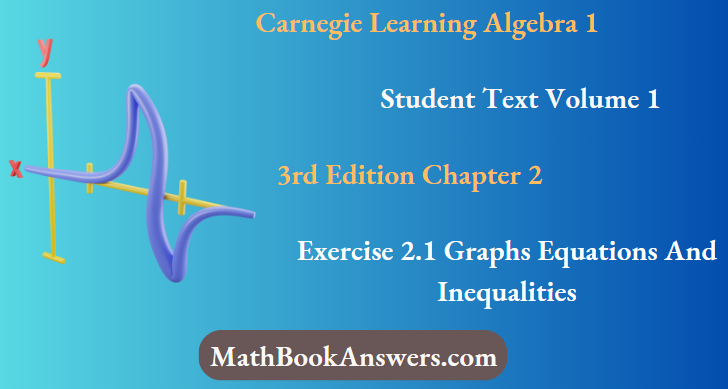
Page 74 Problem 3 Answer
Given: Which function family do you think best represents this situation.
To find the represents this situation.Using the explanation method.
To find function family do you think best represents this situation are,
The situation shows a linear function because the rate the plane ascends is constant.
So, this situation belongs to the linear function family.
This situation belongs to the linear function family.
Carnegie Learning Algebra I Chapter 2 Exercise 2.1 Solutions
Carnegie Learning Algebra I Student Text Volume 1 3rd Edition Chapter 2 Exercise 2.1 Graphs Equations And Inequalities Page 75 Problem 4 Answer
Given: Write the independent and dependent quantities and their units of measure in the table.
To find the dependent quantity values for each of the independent quantity values.
Using the method of graphical.
To find dependent quantity values and independent quantity values are,
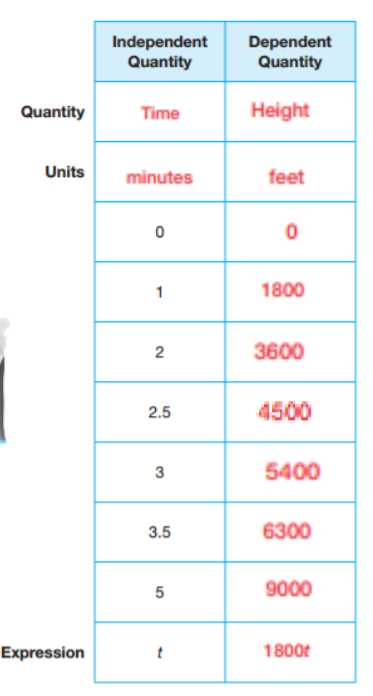
The independent quantity and dependent quantity values are,
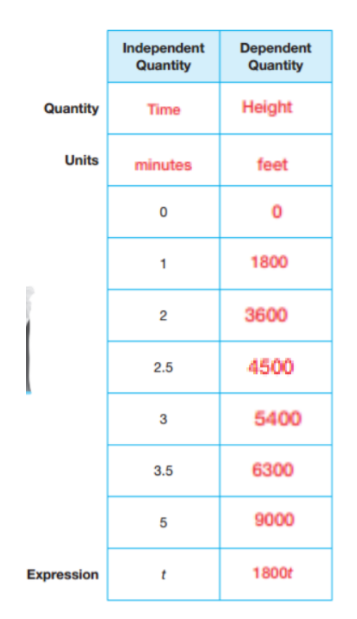
Page 76 Problem 5 Answer
Given: The first differences in the tableTo find what do you notice about the first differences in the table.Using the method subtraction.
From the given,
The first differences in the table,
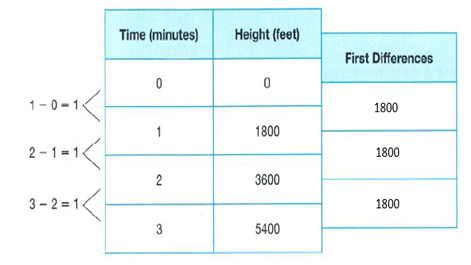
The first difference were all 1800. This means graph has a constant rate of change of 1800.
The first differences in the table were all 1800. This means graph has a constant rate of change of 1800.
Page 76 Problem 6 Answer
Given:
Time (minutes) Height (feet)
2.5 4500
3 5400
5 9000
(2.5,4500) and (3,5400)
To calculate the rate of change between the points represented by the given ordered pairs in the section of the table shown.Using the method rate of change.
From the given,
Let (x1,y1)=(2.5,4500)
(x2,y2)=(3,5400)
The rate of change is then,y2−y1/x2−x1
=5400−4500/3−2.5
=900/0.5
=1800.
The rate of change between the points represented by the given ordered pairs (2.5,4500)and (3,5400) is 1800.
Carnegie Learning Algebra I Student Text Volume 1 3rd Edition Chapter 2 Exercise 2.1 Graphs Equations And Inequalities Page 76 Problem 7 Answer
Given:
Time (minutes) Height (feet)
2.5 4500
3 5400
5 9000
(3,5400) and (5,9000)
To calculate the rate of change between the points represented by the given ordered pairs in the section of the table shown.Using the method rate of change.
From the given,
Let (x1,y1)=(3,5400)
(x2,y2)=(5,9000)
The rate of change is then,y2−y1/x2/−x1
=9000−5400/5−3
=3600/2
=1800.
The rate of change between the points represented by the given ordered pairs (3,5400)and (5,9000) is 1800.
Page 76 Problem 8 Answer
Given:
Time (minutes) Height (feet)
2.5 4500
3 5400
5 9000
(2.5,4500) and (5,9000)
To calculate the rate of change between the points represented by the given ordered pairs in the section of the table shown.Using the method rate of change.
From the given,
Let (x1,y1)=(2.5,4500)
(x2,y2)=(5,9000)
The rate of change is then,
y2−y1/x2−x1
=9000−4500/5−2.5
=4500/2.5
=1800.
The rate of change between the points represented by the given ordered pairs (2.5,4500) and (5,9000) is 1800.
Page 77 Problem 9 Answer
Given: The rates of changeTo find what you notice about the rates of change. Using the method rate of change.
From the given,
Time (minutes) Height (feet)
2.5 4500
3 5400
5 9000
Notice about the rates of change, the rate of change between (2.5,4500) and (3,5400),(3,5400) and (5,9000),(5,9000) and (2.5,4500) is equal to 1800.
The rate of change for each pair of ordered pairs is equal to 1800.
The rate of change for each pair of ordered pairs is equal to 1800.
Page 77 Problem 10 Answer
Given: The rate of change and the unit rate of change.
Use your answers from Question 7 through Question 10 to describe the difference between a rate of change and a unit rate of change. Using the method rate of change.
From the given, A rate of change is a ratio of two quantities such as 900/2 m/sec.
A unit rate of change is the rate of change rewritten to have a denominator of 1.
The unit rate of change of 900/2 m/sec is 450 m/sec which means,900/2
=450/1.
The difference between a rate of change and a unit rate of change is that the rate of change is a ratio of two quantities and a unit rate of change is the rate of change rewritten to have a denominator of 1.
Graphs, Equations, And Inequalities Chapter 2 Exercise 2.1 Answers
Carnegie Learning Algebra I Student Text Volume 1 3rd Edition Chapter 2 Exercise 2.1 Graphs Equations And Inequalities Page 77 Problem 11 Answer
Given: The first differences and the rates of change between ordered pairs demonstrate that the situation represents a linear function.
To find how the first differences and the rates of change between ordered pairs demonstrate that the situation represents a linear function.
Using the method first difference and rate of change.
From the given, The first differences and the rates of change between ordered pairs demonstrate that the situation represents a linear function:
If the first differences have a constant difference for the x- x-coordinate and a constant difference for the y- coordinate, then the ordered pairs represent the linear function.
If each rate of change between ordered pairs is equal to a constant number, then the ordered pairs represent a linear function.
This is because a linear function is defined as a function with a constant rate of change ( its slope).
If the first difference and the rates of change between ordered pairs are constant then the first differences and the rates of change between ordered pairs demonstrate that the situation represents a linear function.
Page 77 Problem 12 Answer
Alita says that for a car to keep up with the plane on the ground, it would have to travel at only 20.5 miles per hour.
To find Alita is correct. Using the method of explanation.
To find Alita is correct.
Alita is not correct.
1800 feet per minute indeed is about 20.5
miles per hour, but this rate compares height to time, not horizontal distance to time.
The plane is ascending at about 20.5 miles per hour, but its horizontal speed, or ground speed, is probably much faster.
Alita is not correct.
1800 feet per minute is indeed about 20.5 miles per hour, but this rate compares height to time, not horizontal distance to time.
Page 78 Problem 13 Answer
Given: The table
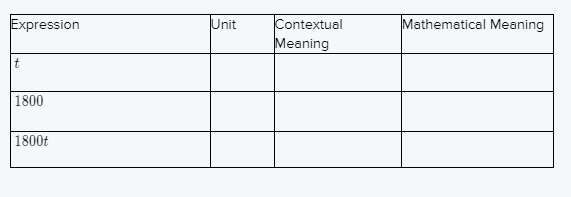
To complete the table shown for the problem situation described in Problem 1, Analyzing Tables.
Using the method of analyzing expression.
From the given,t is the independent variable and has a unit of minutes. It is an input value and its contextual meaning is how long, in minutes, the plane has been flying in the air.
1800 is the given rate of change in feet per minute. Its contextual meaning is how fast the plane is ascending, so it is how many feet the plane climbs per minute.
1800t is the expression with unit feet. Its contextual meaning is the height of the plane in feet. It depends on the time in minutes, it is the output value.
The table is then filled as,
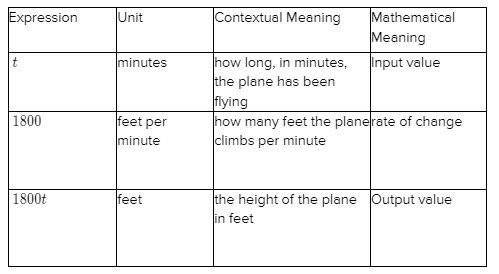
Hence, The table is filled as,
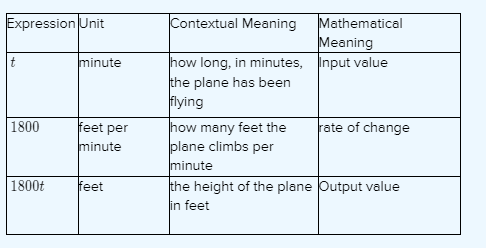
Carnegie Learning Algebra I Student Text Volume 1 3rd Edition Chapter 2 Exercise 2.1 Graphs Equations And InequalitiesPage 80 Problem 14 Answer
Given: The plane is at 3600 feet.To list the different ways the height of the plane is represented in the example.
Using the method of simplification.
Find the different ways the height of the plane;
The plane is at 3600 feet,
The height of the plane after t minutes is represented by both h(t) and 1800 t
Substitutet=2,
The height of the plane after 2 minutes is h(2)=1800(2)=3600.
The height of the plane is 3600.
Page 80 Problem 15 Answer
Given: h(3)=.
To write a complete sentence to interpret your solution in terms of the problem situation.Using the method of simplification.
To write a complete sentence;
Simplify, The height of the plane at each time in minutes,
h=1800
h(3)=1800(3)
=5400.
The height of the plane after 3 minutes is 5400 feet.
The height of the plane after 3 minutes is 5400 feet.
Page 80 Problem 16 Answer
Given:h(5.1).
To write a complete sentence to interpret your solution in terms of the problem situation.Using the method of simplification.
To write a complete sentence;
Simplify, The height of the plane at each time in minutes,
h=1800
h(5.1)=1800(5.1)
=9180.
The height of the plane after 5.1 minutes is 9180 feet.
The height of the plane after 5.1 minutes is 9180 feet.
Page 80 Problem 17 Answer
Given:h(−4).
To write a complete sentence to interpret your solution in terms of the problem situation.
Method used: Simplification.
To write a complete sentence;
Simplify, The height of the plane at each time in minutes,
h=1800
h(−4)=1800(−4)
=−7200.
This ordered pair is not a solution in terms of the problem situation since time cannot be negative.
This ordered pair is not a solution in terms of the problem situation since time cannot be negative.
Carnegie Learning Algebra I Graphs, Equations, And Inequalities Solutions
Carnegie Learning Algebra I Student Text Volume 1 3rd Edition Chapter 2 Exercise 2.1 Graphs Equations And Inequalities Page 81 Problem 18 Answer
Given:h(t)=1800t.
To find out why can you substitute 7200 for h(t)?Using the method of substitute.
Find7200 for h(t);
The expression h(t) represents the height of the plane after t minutes,
The plane 4 minutes to reach a height of 7200 feet.
7200 is the possible height of the plane,
Substitute 7200 for h(t).
7200 is a possible height of the plane and h(t) represents the height of the plane after t minutes.
Page 81 Problem 19 Answer
Given: 5400 feet.
To write a complete sentence to interpret your solution in terms of the problem situation.
Method used: Simplification.
To write a complete sentence;
Simplify,
h(t)=1800t
5400=1800t
5400/1800=1800t
1800/3=t.
The height of the plane is 5400 feet 3 minutes after takeoff.
Carnegie Learning Algebra I Student Text Volume 1 3rd Edition Chapter 2 Exercise 2.1 Graphs Equations And Inequalities Page 81 Problem 20 Answer
Given:9000 feet.
To write a complete sentence to interpret your solution in terms of the problem situation.Using the method of simplification.
To write a complete sentence;
Simplify,
h(t)=1800t
9000=1800t/9000
1800=1800t/1800
5=t.
The height of the plane is 9000 feet, 5 minutes after takeoff.
Page 81 Problem 21 Answer
Given:3150 feet.
To write a complete sentence to interpret your solution in terms of the problem situation.
Using the method of simplification.
To write a complete sentence;
Simplify,
h(t)=1800t
3150=1800t
3150/1800=1800t/1800
1.75=t.
The height of the plane is 3150 feet 1.75 minutes after takeoff.
Page 81 Problem 22 Answer
Given:4500feet.
To write a complete sentence to interpret your solution in terms of the problem situation.
Using the method of simplification.
To write a complete sentence;
Simplify,
h(t)=1800t
4500=1800t
4500/1800=1800t/1800
2.5=t.
The height of the plane is 4500 feet2.5 minutes after takeoff.
Exercise 2.1 Graphs, Equations, And Inequalities Explained
Carnegie Learning Algebra I Student Text Volume 1 3rd Edition Chapter 2 Exercise 2.1 Graphs Equations And Inequalities Page 82 Problem 23 Answer
Given:7200=1800t.
To find what doest,h(t) represent?Using the method of graphical.
To find t,h(t)represent;After takeoff, it takes the plane4 minutes to reach a height of 7200 feet,
h(t)=1800t
7200=1800t
=(4,7200)
(t,h(t)) represents the ordered pairs on the graph of h(t)=1800t.
(t,h(t)) represents the ordered pairs on the graph of h(t)=1800t.
Page 82 Problem 24 Answer
Given:h(t)=1800t,
y=1800x.
To explain the connection between the form of the given function and the equation in terms of the independent and dependent quantities.Using the method of graphical.
To explain the connection between the form of the given function and equation;h(t)=1800t,
The independent quantity is t,The dependent quantity is h(t),y=1800x, The independent quantity is x,
The dependent quantity is y.
The two functions then represent the same relationship between the height of the plane and the time the plane is in flight.
The two functions represent the same relationship between the height of the plane and the time the plane is in flight.
Page 82 Problem 25 Answer
Given:h(t)=1800t,
y=1800x.
To explain the connection between the form of the given function and the equation in terms of the independent and dependent quantities.Using the method of graphical.
To explain the connection between the form of the given function and equation;h(t)=1800t, The independent quantity is t, The dependent quantity is h(t),y=1800x, The independent quantity is x, The dependent quantity is y.
The two functions then represent the same relationship between the height of the plane and the time the plane is in flight.
The two functions represent the same relationship between the height of the plane and the time the plane is in flight.
Carnegie Learning Algebra I Student Text Volume 1 3rd Edition Chapter 2 Exercise 2.1 Graphs Equations And Inequalities Page 83 Problem 26 Answer
Given: Using the graphing method to the solutions.To find where you used an algebraic method. What do you notice? Using the method of graphical.
To find where you used an algebraic method;
It was algebraically h(t)=5400
t=3,
h(t)=9000,
t=5,
h(t)=3150
t=1.75,
h(t)=4500
t=2.5.
It was graphically h(t)=5400
t=3,
h(t)=9000
t=5,
h(t)=3150
t=1.75
h(t)=4500
t=2.5.
Both graphical and algebraical methods give the same results t=2.5.
Page 84 Problem 27 Answer
Given: In a table.
To describe how a linear function is represented.Using the method of linear functions.
To describe how a linear function is represented;
In a table, For example, A common equation for linear function,
y=mx+b
y=mx+b
From a table, a linear function by examining the x and y values.
A table of values for a linear function shows a constant rate of change between the x and y values.
A linear function is represented as ordered pairs with constant first differences or constant rates of change.
Carnegie Learning Algebra I Student Text Volume 1 3rd Edition Chapter 2 Exercise 2.1 Graphs Equations And Inequalities Page 84 Problem 28 Answer
Given: In a graph.To describe how a linear function is represented.Using the method of linear functions.
To describe how a linear function is represented;
In a graph, The graph of a linear function is a straight line.
Graphically, where the line crosses the x-axis, is called a zero, or root.
Algebraically, a zero is an x value at which the function of x is equal to 0.
A linear function is represented as a straight line.
Page 84 Problem 29 Answer
Given: In an equation.To describe how a linear function is represented.Using the method of linear functions.
To describe how a linear function is represented;
In an equation,
The formulay=mx+b is said to be a linear function.
The graph of this function will be a straight line on the (x,y) plane.
The function for a line is expressed this way, called the ‘slope-intercept form’.
A linear function is represented as an equation of the form that is y=mx+b.
Page 84 Problem 30 Answer
Given: Algebraic method.
To find when determining solutions for linear functions.
Using the graphical method.
The graphical method helps find a wide range of solutions but, the solutions may have to be estimated if it is difficult to determine the exact coordinates of the point of intersection.
The algebraic method is useful because the exact solutions can always be found but the equation can be difficult to solve sometimes.
The graphical method helps find a wide range of solutions.
The algebraic method is useful because the exact solutions can always be found.
Chapter 2 Exercise 2.1 Carnegie Learning Guide
Carnegie Learning Algebra I Student Text Volume 1 3rd Edition Chapter 2 Exercise 2.1 Graphs Equations And Inequalities Page 84 Problem 31 Answer
Given: Graphing method.
To find the graphing method for determining solutions will work for any function?
Using the graphical method.
The graphing method for determining solutions:
The graphing method for determining solutions will not work for any function.
The graphical method can always be used to find an estimate for a solution but sometimes the exact solution cannot be found.
No, because the exact solution cannot always be found graphically.
No, because the exact solution cannot always be found graphically.
Page 85 Problem 32 Answer
Given:7x+2=−12.
To solve each equation and justify reasoning.
Using the arithmetic functions.
Solve each equation and justify:
7x+2=−12
Subtract 2 on both sides
7x+2−2=−12−2/7x=−14
Divide both sides by 7
7x/7=−14/7
x=−2
Check the given equation:
7(−2)+2=?−12
−14+2=?−12
−12=−12
Solving the equation7x+2=−2, we getx=−2.
Page 85 Problem 33 Answer
Given :4(x+−7)+12=20.
To solve each equation and justify reasoning.
Using the arithmetic functions.
Solve each equation and justify:
4(x+−7)+12=20
4x+4(−7)+12=20
4x−28+12=20
4x−16=20
Add16 on both sides
4x−16+16=20+16
4x=36
Divide both sides by 4
4x/4=36/4
x=9
Check the given equation:
4(9+−7)+12=? 20
4(2)+12=? 20
8+12=? 20
20=20
Solving the equation4(x+−7)+12=20,we getx=9.
How To Solve Graphs, Equations, And Inequalities Exercise 2.1
Carnegie Learning Algebra I Student Text Volume 1 3rd Edition Chapter 2 Exercise 2.1 Graphs Equations And Inequalities Page 85 Problem 34 Answer
Given:14x−13=9x+1.
To solve each equation and justify reasoning.
Using the arithmetic functions.
Solve each equation and justify:
14x−13=9x+1
Add 13 on both sides
14x−13+13=9x+1+13
14x=9x+14
Subtract 9x on both sides
14x−9x=9x+14−9x
5x=14
Divide both sides by 5x5x/5
=14/5
x=2.8
Check the given equation:
14(2.8)−13=? 9(2.8)+1
39.2−13=? 25.2+1
26.2=26.2
Solving the equation14x−13=9x+1,
we get x=2.8.
Page 85 Problem 35 Answer
Given:x+2/6=2/5.
To solve each equation and justify reasoning.
Using the arithmetic functions.
Solve each equation and justify:
x+2/6=2/5
Multiply both sides by 6/6⋅x+2/6
=6⋅2/5
x+2=12/5
Subtract 2 on both sides
x+2−2=12/5−2
x=12/5−2
Get a common denominator on the right.
x=12/5−10/5
x=2/5
Rewrite as a decimal
x=0.4
Check the given equation:
0.4+2/6=? 2/5
2.4/6=? 0.4
0.4=0.4
Solved the given equation x+2/6=2/5, we getx=0.4.
